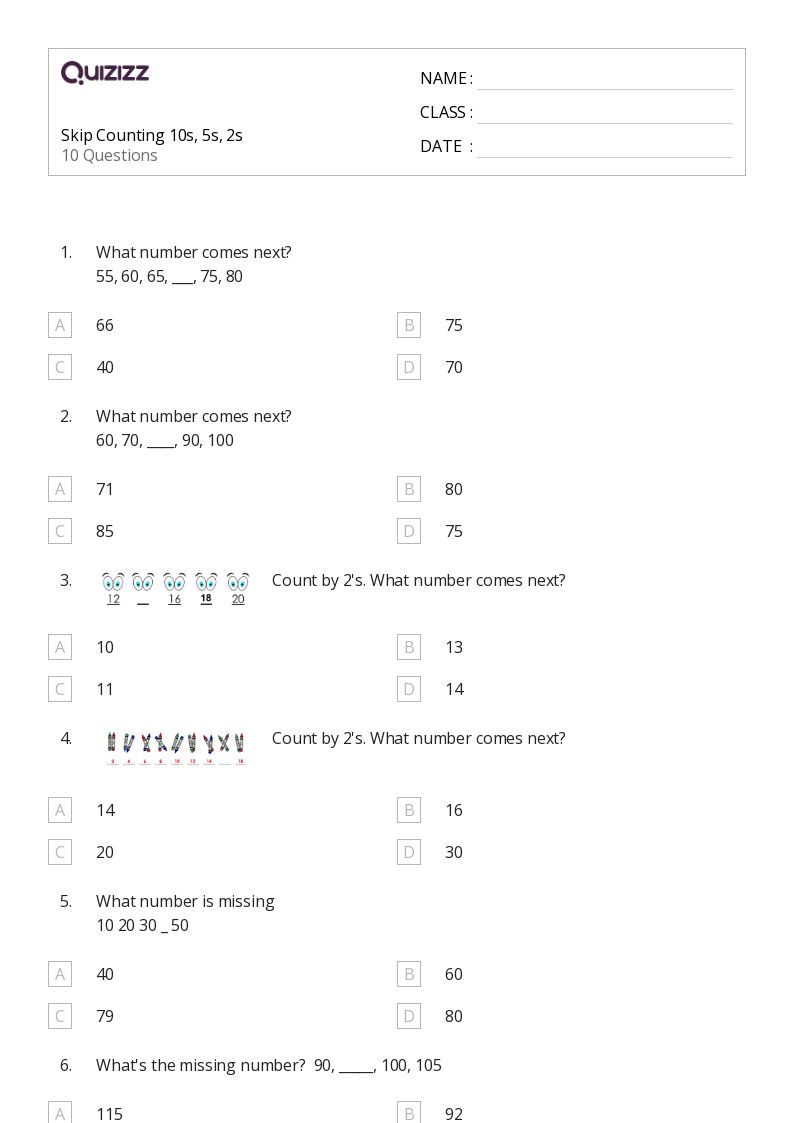Unlocking Number Patterns: Skip Counting by 2s, 5s, and 10s

Imagine effortlessly navigating number lines, predicting patterns, and grasping the foundations of multiplication. This is the potential unlocked by skip counting, a fundamental mathematical skill that lays the groundwork for more complex concepts. Skip counting, also known as counting by intervals, involves counting forward or backward by numbers other than 1. This article delves into the world of skip counting by 2s, 5s, and 10s, exploring its history, benefits, and practical applications.
Skip counting, in its simplest form, is a way to efficiently count by adding a consistent interval to each number. Think of it as hopping along the number line, landing on specific multiples. While the precise origins of skip counting are difficult to pinpoint, its roots are entwined with the development of early number systems and the practical need for efficient counting methods in trade, measurement, and daily life. Ancient civilizations likely used forms of skip counting long before formal mathematics emerged. Its importance lies in its ability to simplify calculations and establish the foundation for understanding multiplication and division.
One of the primary challenges in learning skip counting is internalizing the patterns. Unlike simple counting by ones, skip counting requires recognizing and reproducing specific sequences. This can be initially difficult for young learners, especially those still developing their number sense. However, with consistent practice and engaging activities, children can master these sequences and reap the rewards of improved numerical fluency.
Let's break down skip counting by 2s, 5s, and 10s with clear definitions and examples. Counting by 2s involves adding 2 to each subsequent number (2, 4, 6, 8, 10…). Counting by 5s uses an interval of 5 (5, 10, 15, 20, 25…) and counting by 10s uses an interval of 10 (10, 20, 30, 40, 50…). These specific intervals are often introduced early in mathematics education because they form the basis of our base-ten number system.
The benefits of mastering skip counting extend beyond simple arithmetic. Firstly, it improves number sense and familiarity with number sequences. Secondly, it lays the groundwork for understanding multiplication and division, as these operations are essentially repeated addition and subtraction. Thirdly, it strengthens mental math skills and improves overall mathematical fluency.
An effective action plan for learning skip counting involves consistent practice and engaging activities. Start with concrete objects, like blocks or coins, to visualize the counting process. Use number lines and charts to reinforce the visual patterns. Incorporate games, songs, and real-world examples to make learning fun and relevant. For instance, counting pairs of socks, groups of five fingers, or stacks of ten pennies can connect skip counting to everyday experiences.
Step-by-step Guide to Skip Counting by 2s:
1. Start at 2.
2. Add 2 to get the next number: 2 + 2 = 4.
3. Continue adding 2: 4 + 2 = 6, 6 + 2 = 8, and so on.
Repeat this process for 5s and 10s, adjusting the interval accordingly.
Advantages and Disadvantages of Focusing Primarily on Skip Counting by 2s, 5s, and 10s
| Advantages | Disadvantages |
|---|---|
| Establishes a strong foundation for understanding base-ten. | Can lead to a reliance on these specific intervals, hindering flexibility with other numbers. |
| Directly connects to multiplication and division facts. | May not adequately challenge more advanced learners who are ready for more complex skip counting patterns. |
Best Practice: Use Visual Aids like number lines and hundred charts.
Real Example: Counting money using coins.
Challenge: Difficulty memorizing sequences. Solution: Use rhythmic chanting and songs.
FAQ: What is the purpose of skip counting? Answer: To build a foundation for multiplication and division.
Tip: Practice skip counting regularly, even for a few minutes each day.
In conclusion, skip counting by 2s, 5s, and 10s is more than just a basic math skill; it's a gateway to deeper mathematical understanding. By mastering these fundamental number patterns, learners equip themselves with the tools necessary for success in multiplication, division, and beyond. The ability to recognize and manipulate number sequences empowers students to approach math with confidence and fluency. From counting coins to understanding complex algorithms, skip counting plays a crucial role in shaping mathematical thinking. Embrace the power of skip counting, and watch your mathematical abilities flourish.
Discover santiagos vibrant dining scene your culinary guide
Unlocking the secrets of sherwin williams pewter gray
Bungalow interior design ideas cozy charm meets modern style













